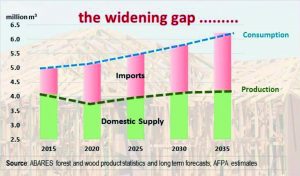The Australian timber industry is now staring down the barrel of a big problem; the growing gulf between the supply of domestically produced softwood timber and rising consumer demand. The timber production shortfall is estimated to reach up to 1.8 million cubic metres of softwood timber by 2035.
Ross Hampton, CEO of the Australian Forest Products Association (AFPA), said “This gulf equates to 128,000 new homes per year that could, and ideally should, be constructed out of Australian timber.”
With national plantation failing to meet the demand for timber construction, softwoods are increasingly being imported, presenting a significant problem for the timber industry. Ron Adams, the Managing Director of Wespine Industries in Western Australia has seen the shortfall issue first hand.
“Our sawmill can only work at 70 per cent of its operating capacity due to the lack of available timber. Over the longer term this may have to reduce even further,” commented Mr Adams.
So what is the solution to this growing problem? According to Jon Kleinschmidt, CEO of Hyne Timber in Queensland, the only solution is to increase the number of Australian plantations. Mr Kleinschmidt said “It’s a basic formula: we will need more trees in the future to increase production and remain competitive in the global market.”
This is easier said than done, with investment in new plantations in Australia now at a standstill. Plantations are a vital downstream industry, and the lack of growth in this area is leading to many domestic processing plants, like Wespine Industries, operating below capacity due to a lack of available timber resources.
Mr Hampton believes the answer might be in policy reform, stating “Establishing new plantations to produce timber for new houses is now vital. Forest industries call on the government to grow Australia’s capacity to meet this demand and support AFPA’s new policy proposal, Plantations – the missing piece of the puzzle.”
For further information visit ausfpa.com.au









